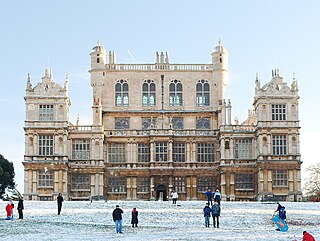
Wollaton Hall is an Elizabethan country house of the 1580s standing on a small but prominent hill in Wollaton Park, Nottingham, England. The house is now Nottingham Natural History Museum, with Nottingham Industrial Museum in the outbuildings. The surrounding parkland has a herd of deer, and is regularly used for large-scale outdoor events such as rock concerts, sporting events and festivals.
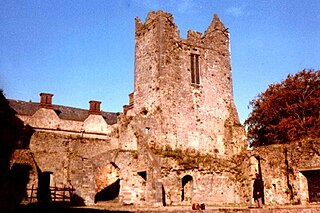
Ormond Castle is a castle on the River Suir on the east side of Carrick-on-Suir, County Tipperary, Ireland. The oldest part of the existing castle is a mid-15th century walled bawn, cornered on the northeast and northwest by towers.
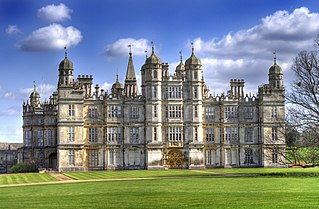
Burghley House is a grand sixteenth-century English country house near Stamford, Lincolnshire. It is a leading example of the Elizabethan prodigy house, built and still lived in by the Cecil family. The exterior largely retains its Elizabethan appearance, but most of the interiors date from remodellings before 1800. The house is open to the public on a seasonal basis and displays a circuit of grand and richly furnished state apartments. Its park was laid out by Capability Brown.

Acton Beauchamp is a village and civil parish in Herefordshire, England. It is approximately 12 miles (19 km) north-east from the city and county town of Hereford, and 3 miles (5 km) south-east from the market town of Bromyard.

Urishay constitutes the remains of a castle, 16th century chapel and 17th century house located about 2.5 km west of Peterchurch in Herefordshire, England.

North Herefordshire is a constituency represented in the House of Commons of the UK Parliament since its 2010 creation by Bill Wiggin, a Conservative.
The Golden Valley is the name given to the valley of the River Dore in western Herefordshire, England. The valley is a picturesque area of gently rolling countryside. It lies in the lee of the Black Mountains, Wales.
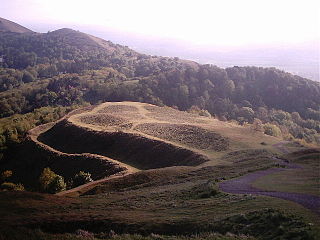
The Herefordshire Beacon is one of the highest peaks of the Malvern Hills, and is high enough to be classified as a mountain. It is surrounded by a British Iron Age hill fort earthwork known as British Camp. The fort subsequently had a ringwork and bailey castle built inside its boundary and there is evidence of 120 huts in the area. British Camp has been a scheduled monument since 1923.

British Camp is an Iron Age hill fort located at the top of Herefordshire Beacon in the Malvern Hills. The hill fort is protected as a Scheduled Ancient Monument and is owned and maintained by Malvern Hills Conservators. The fort is thought to have been first constructed in the 2nd century BC. A Norman castle was built on the site.
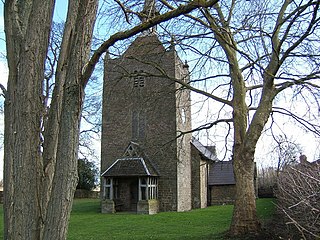
Rotherwas Chapel is a family chapel, once belonging to the Bodenham family. It is now state-owned and administered by English Heritage. The chapel contains structures from medieval, Elizabethan, Georgian and Victorian periods. The originally simple medieval building has a fine Elizabethan timber roof, a rebuilt 18th century tower, and striking Victorian interior decoration with furnishings by the Pugins.

Burton Agnes Hall is an Elizabethan manor house in the village of Burton Agnes, near Driffield in the East Riding of Yorkshire, England. It was built by Sir Henry Griffith in 1601–10 to designs attributed to Robert Smythson. The older Norman Burton Agnes Manor House, originally built in 1173, still stands on an adjacent site; both buildings are now Grade I listed buildings.

Hereford Castle is a castle that used to be in the cathedral city of Hereford, the county town of Herefordshire, England. Founded sometime before 1052, it was one of the earliest castles in England. Hereford Castle was probably destroyed when the Welsh sacked Hereford in 1055, but seems to have been replaced by the following decade. During the civil war of King Stephen's reign, the castle was besieged three times; the garrison surrendered each time and control of Hereford Castle changed hands.
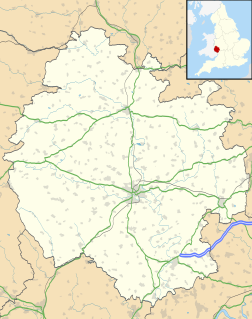
Kinnersley is a village in Herefordshire, England. Home to around 100 residents, it is located about 5 miles (8 km) east of the Wales-England border and 10 miles (16 km) north west of Hereford.

Brimfield is a village and civil parish in north Herefordshire, England. The village lies on the A49 road at the border with Shropshire.
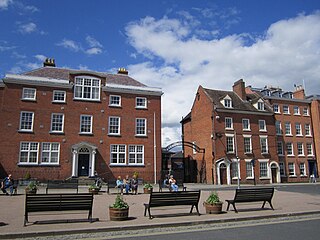
Ludlow College is a sixth form college situated in the heart of Ludlow, Shropshire, England. It now forms part of the Herefordshire and Ludlow College, though retains its own identity.

Midsummer Hill is situated in the range of Malvern Hills that runs approximately 13 kilometres (8 mi) north-south along the Herefordshire-Worcestershire border. It lies to the south of Herefordshire Beacon with views to Eastnor Castle. It has an elevation of 284 metres (932 ft). To the north is Swinyard Hill. It is the site of an Iron Age hill fort which spans Midsummer Hill and Hollybush Hill. The hillfort is protected as a Scheduled Ancient Monument and is owned by Natural England. It can be accessed via a footpath which leads south from the car park at British Camp on the A449 or a footpath which heads north from the car park in Hollybush on the A438.
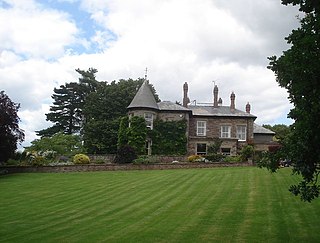
Brobury is a village in western Herefordshire, England, located between Hereford and Hay-on-Wye.

William Smallman of Kinnersley Castle, Herefordshire was an English politician who sat in the House of Commons in 1640.

Henry Garratt-Adams was a British philatelist, philatelic publisher and dealer in philatelic literature based in Kinnersley Castle in Herefordshire, England. After his death, a large hoard of philatelic literature was found at the castle that included many rare items dating to the earliest days of philately.

Staunton on Arrow is a village and civil parish in the county of Herefordshire, England, and is 17 miles (27 km) north-west from the city and county town of Hereford. The closest large town is the market and minster town of Leominster, 8 miles (13 km) to the east. Within the parish is the site of the Iron Age hill fort of Wapley Hill.



















